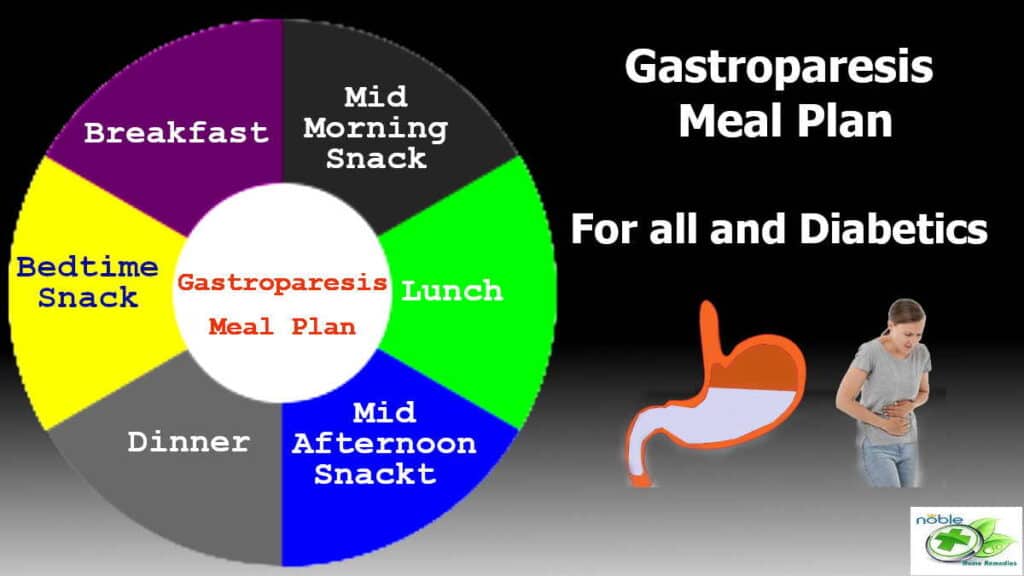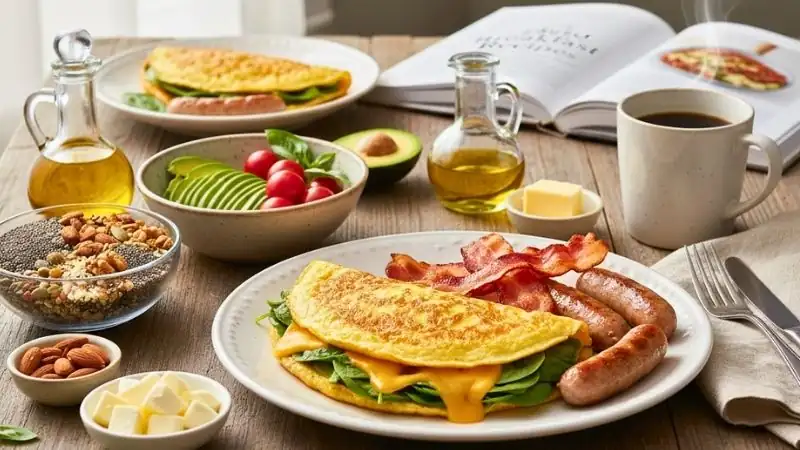Gastroparesis Diet Recipes: Your Easy-To-Digest Meal Guide
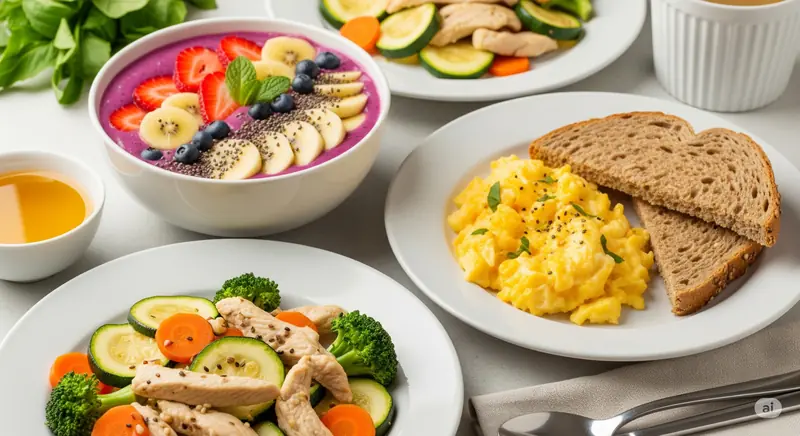
Living with gastroparesis can feel like a constant puzzle, especially when it comes to figuring out what to eat. This condition, where your stomach takes too long to empty its contents into the small intestine, often brings challenging symptoms such as nausea, vomiting, bloating, and heartburn. You might also feel full very quickly, experience abdominal discomfort, or even have irregular blood sugar levels and unintended weight loss. It’s a journey that can be frustrating and isolating, but you do not have to go through it alone. Many people with gastroparesis find that changes to their diet are often the first and most important step in feeling better.
The primary goal of a gastroparesis diet is to alleviate your symptoms and ensure your body receives all the necessary nutrition. This means staying hydrated, getting enough calories and protein, and making sure you receive essential vitamins and minerals. While diet isn’t a “cure,” it can significantly help you manage the condition and improve your daily life. So, keep reading for your Gastroparesis Diet Recipes.
Understanding Gastroparesis and Why Diet Matters
Gastroparesis can be triggered by various factors, including illnesses or chronic conditions such as diabetes or lupus. For many, the underlying cause is damage to the vagus nerve, which is a crucial nerve responsible for moving food through the digestive system. High blood sugar levels, common in diabetes, can interfere with normal stomach emptying, making gastroparesis problems worse.
When your stomach empties too slowly, food can sit there for a long time, leading to those uncomfortable symptoms. This is why what you eat and how you eat it becomes so incredibly important. By choosing the right “gastroparesis diet recipes” and meal habits, you can help your stomach do its job more effectively and lessen the burden on your digestive system.
Core Principles of a Gastroparesis-Friendly Diet
Navigating a friendly diet for gastroparesis might seem overwhelming at first, but with some key principles, you can create a plan that works for you. Remember, everyone is different, and what helps one person might not be the same for another. It’s always best to work closely with your healthcare professional or a dietitian to create a personalized dietary plan that fits your unique needs.
Here are the main guidelines to keep in mind:
- Eat Small, Frequent Meals
- Limit Fat Intake
- Reduce Fiber Intake
- Prioritize Consistency
- Stay Hydrated
- Chew Your Food Well
- Mindful Eating and Mealtime Habits
- Avoid Alcohol
- Manage Blood Sugar (for Diabetic Gastroparesis)
- Consider Gentle Movement
Foods to Include in Your Gastroparesis Diet with Gastroparesis Diet Recipes
Focusing on foods that are low in fat and fiber, easy to digest, and offer good nutrition is key. Here are some categories of foods and delicious gastroparesis diet recipes you can incorporate:
Proteins (Lean and Easy to Digest)
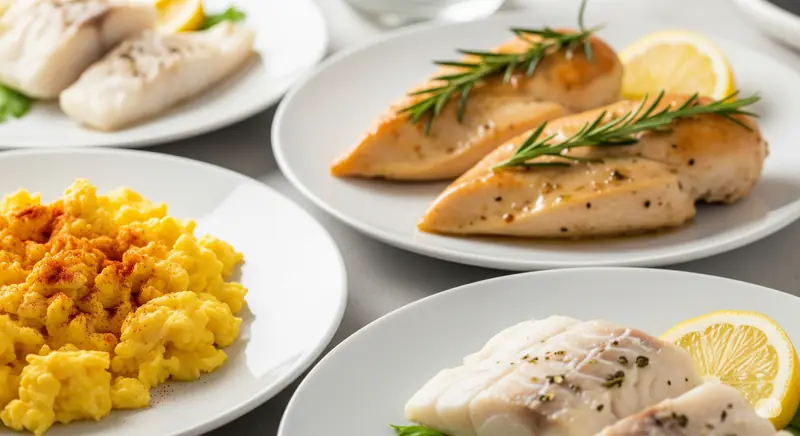
Lean protein sources are vital for maintaining strength and muscle mass.
- Eggs: Scrambled eggs or baked omelet muffins are excellent choices.
- Poultry: Baked or shredded chicken or turkey are good options.
- Smooth Peanut Butter: A great source of protein, especially when blended into smoothies or spread on low-fiber toast.
- Fish: White fish like cod, haddock, or salmon, baked or canned, are usually well-tolerated due to their flaky, light nature.
- Low-Fat Dairy: Low-fat yogurt and cottage cheese provide protein and calcium.
Here are some specific gastroparesis diet recipes for protein:
Banana Protein Smoothie
This smoothie is a fantastic way to get protein and calories in a liquid form that’s easy to digest.
- Ingredients:
- ½ of a frozen banana
- ½ cup unsweetened vanilla aalmond milk
- 1 tablespoon protein powder or PB2
- Instructions:
- Blend all ingredients together until smooth. Enjoy!
Omelet Muffins
These are perfect for a quick breakfast or snack, and you can make a batch ahead of time.
- Ingredients:
- Eggs (quantity depends on how many muffins you want to make)
- Cooked spinach (amount to your liking)
- Low-fat shredded cheese (amount to your liking)
- Instructions:
- Whisk eggs and mix in cooked spinach and low-fat shredded cheese.
- Pour the mixture into muffin tins (lightly greased or lined) [recipe template].
- Bake until set and lightly golden [76, recipe template].
- Store in the fridge for easy grab-and-go meals or snacks.
Carbohydrates (Refined and Low-Fiber)
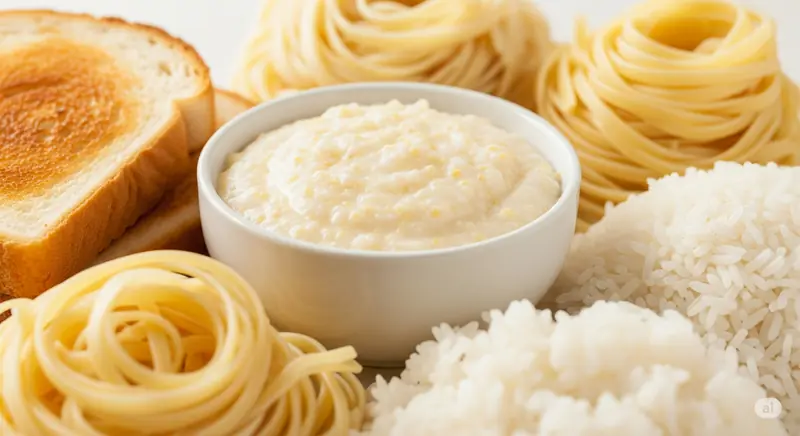
Choosing refined, low-fiber carbohydrates can help with easier digestion.
- White Breads: White toast and low-fiber crackers are often well-tolerated.
- Low-Fiber Cereals: Cream of Wheat® and grits are good options. You can add honey, maple syrup, or protein powder for more flavor and nutrition.
- Pasta and White Rice: These are also easy to digest.
Fruits (Peeled, Cooked, or Pureed)
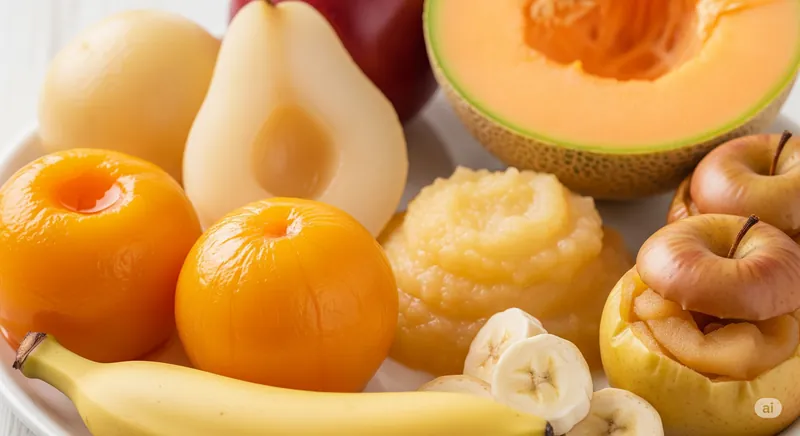
Raw fruits with skins and seeds are often difficult, so focus on these:
- Canned Fruits: Peaches, pears, applesauce, and mandarin or canned orange/grapefruit sections without membranes.
- Seedless Melons: Cantaloupe and watermelon are good choices.
- Ripe Banana: A fantastic, easy-to-digest fruit.
- Cooked or Pureed Fruits: Baked apples or pears, and any pureed fruits work well.
Try this gastroparesis diet recipe for a fruity treat:
Super Smoothie
This smoothie is packed with fruit and can be a delightful way to get vital nutrients.
- Ingredients:
- 1 ripe banana
- 3.9 ounces no-sugar-added apple sauce
- 1 tablespoon creamy peanut butter or almond butter
- 1 teaspoon vanilla extract
- ½ teaspoon pumpkin pie spice
- ½ cup no-sugar-added canned sliced peaches
- 2 tablespoons nonfat milk
- ½ tablespoon pure maple syrup or honey
- Instructions:
- Place all the ingredients in a blender.
- Purée until smooth and creamy.
- Refrigerate any leftovers.
Vegetables (Well-Cooked, Peeled, or Pureed)
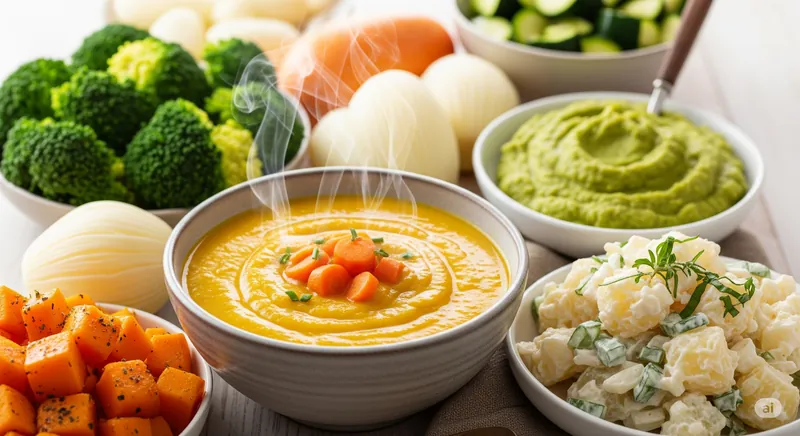
Raw or high-fiber vegetables can be problematic. Stick to well-cooked, peeled, or pureed options:
- Zucchini, Bell Peppers, Carrots, White Potatoes: These are often tolerated when cooked thoroughly.
- Soft Cooked Vegetables: Acorn squash, beets, mushrooms, spinach, summer squash, strained tomato sauce, yams, leeks, onions, roasted skinless peppers, well-cooked and mashed cauliflower, asparagus tips, and mashed avocado.
Here are some excellent gastroparesis diet recipes featuring vegetables:
Sweet Potato Carrot Soup
A warming, nutrient-dense soup that’s gentle on the stomach.
- Ingredients:
- 1 teaspoon olive oil
- 3 ½ cups peeled and chopped sweet potato
- 2 cups peeled and chopped carrots
- 2 ½ cups super firm tofu, cut into chunks (or lean protein of choice)
- 1 teaspoon kosher salt
- ½ teaspoon freshly ground pepper
- 2 teaspoons curry powder
- 4 cups vegetable stock
- 2 tablespoons pure maple syrup
- Instructions:
- Heat olive oil in a medium stock pot over medium-high heat.
- Add sweet potatoes, carrots, and tofu. Season with salt, pepper, and curry powder.
- Sauté for two to three minutes.
- Add vegetable stock and bring to a boil.
- Cover and reduce the heat to a simmer. Cook for 45 minutes or until the vegetables are soft.
- Add maple syrup.
- Purée using an immersion blender until creamy and velvety. If you don’t have an immersion blender, cool the soup completely and purée it in a regular blender or food processor a little at a time.
- Leftovers will keep in the refrigerator for a week or can be divided into smaller portions and frozen.
Mayo-Free Potato Salad
A fresh take on a classic, made gastroparesis-friendly.
- Ingredients:
- Potatoes (peeled and cut into small bite-sized pieces)
- Plain, unsweetened yogurt (plant-based is recommended)
- Cooked onion (red onion works well)
- Cooked green peppers (optional, if tolerated)
- Lemon (optional)
- Parsley (optional, finely chopped)
- Chives (optional)
- Instructions:
- Peel and cut your potatoes into small, bite-sized pieces.
- Boil the potatoes until they are soft but not mushy (a fork should easily go through them).
- Drain the water and rinse the potatoes. Let them cool in a bowl on the counter or in the fridge.
- While potatoes cool, cut onion and/or green pepper (if using) and cook in a pan until soft. Let them cool.
- Finely chop parsley (if using). If you eat anything raw, it should be an herb like parsley, chopped incredibly fine.
- In a small bowl, combine the cooked onion and chopped parsley. Add a little freshly squeezed lemon juice.
- In a medium-sized bowl, combine the cooled potatoes with the onion, lemon, and parsley mixture.
- Add the plain, unsweetened yogurt to your desired consistency, mixing well.
- Cool in the fridge and enjoy! It stores well for 2-3 days.
- Optional: Top with paprika or add hard-boiled egg, shredded turkey, chicken, or avocado for extra protein if tolerated.
Beverages and Supplements
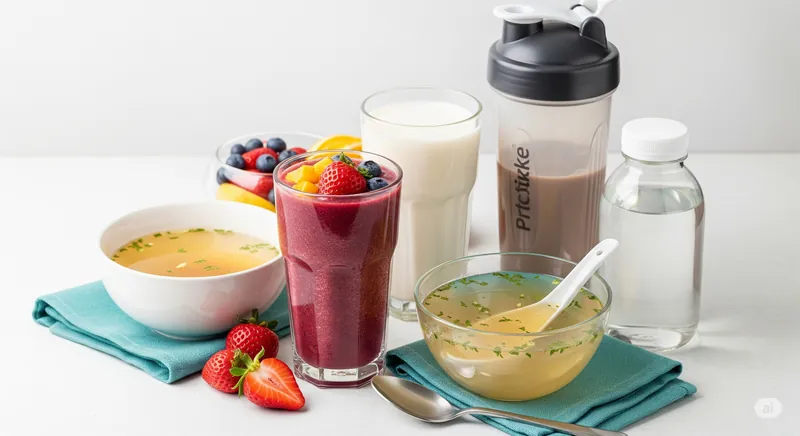
Liquids are generally easiest to digest.
- Soups: Broth-based soups, cream of potato soup, or blended vegetable juices are excellent options. Low-sodium chicken noodle soup with small pieces of chopped carrots, green beans, and celery might be tolerated.
- Smoothies and Protein Shakes: These are fantastic for getting nutrient-dense calories in an easy-to-digest form.
- Liquid Nutritional Supplements: Products like Ensure® or Boost® can provide necessary calories and protein, especially if you’re struggling to eat solids.
Here’s a key gastroparesis diet recipe for a foundational beverage:
Fortified Milk Recipe
This recipe boosts the protein and calorie content of regular milk, making it more nutritious.
- To make 1 quart:
- Ingredients:
- 1 quart of 2% milk (or 1% or skim if you are fat-intolerant)
- 1 cup nonfat powdered milk
- Instructions:
- Add powdered milk to liquid milk in a large, deep bowl or blender.
- Beat slowly with a beater until the powdered milk is dissolved.
- Refrigerate and serve cold. It tastes best when thoroughly chilled.
- Ingredients:
- To make 8 oz (one serving):
- Ingredients:
- 8 oz of 2% milk (or 1% or skim if fat-intolerant)
- 2 tablespoons of nonfat powdered milk
- Instructions:
- Add powdered milk to liquid milk in a large, oversized glass.
- Blend until the powdered milk is dissolved. Each cup of high-protein milk made this way contains around 200 calories and 14 grams of protein.
- Ingredients:
Add-on Foods to Boost Calories and Protein
If you’re worried about not getting enough nutrients or losing weight, consider these additions:
- Avocado: A full avocado can add over 300 calories.
- Creamy Peanut/Nut Butter: Easy to add to toast, smoothies, or even some savory dishes.
- Olive Oil: A tablespoon can add 120 calories.
- Protein Powder: Whey, soy, pea, or rice protein powders can be blended into drinks or soft foods.
- Cheese and Yogurt: Low-fat versions can boost protein.
- Nonfat Powdered Milk: Adding 2 or more tablespoons to hot cereals, scrambled eggs, puddings, or creamed soups can significantly increase calories and protein.
Tips for Enhancing Flavor and Digestibility
Eating a restrictive diet can sometimes feel bland, but it doesn’t have to be! You can still enjoy flavorful meals while managing gastroparesis.
Invest in Kitchen Equipment
Having the right tools can make preparing “gastroparesis diet recipes” much easier. A good quality blender/food processor and an immersion blender are invaluable for liquefying and pureeing foods. An immersion blender is especially useful for pureeing hot soups or sauces without needing to wait for them to cool down.
Smart Cooking Techniques
- Roasting vegetables with minimal oil can bring out deep, nutty flavors as their natural sugars caramelize, and it makes them very soft.
- Braising vegetables in a saucepan with a little vegetable stock can tenderize them beautifully and create a flavorful glaze.
- Remember, do not fry foods; baking or grilling lean protein options is always preferred.
Utilize Prokinetic Herbs and Spices
Many natural herbs and spices can actually help with digestion by promoting gut movement. Common examples include ginger, turmeric, mint, cumin, caraway seeds, and cinnamon. Experiment with these to add flavor and potentially aid your digestion.
Make Food Appetizing
Even with a limited ingredient list, you can make your food satisfying and enjoyable. Think about the five senses: Does it look colorful and inviting? Does it smell good? Does it have a nice texture? Does it sound appetizing when you eat it? And most importantly, do the flavors stimulate your taste buds? Using herbs and spices can transform plain dishes, and even a garnish like a few low-fiber crackers can add a pleasing crunch.
Practice Mindfulness to Savor Each Bite
Try eating pureed foods out of a bowl with a spoon. This simple act can help slow down your eating, which is beneficial for digestion. It also encourages a more mindful approach, allowing you to truly absorb all the smells, sights, and flavors of your food.
Recovering from a Gastroparesis Flare-Up
Sometimes, despite your best efforts, a gastroparesis flare-up might occur. When this happens, easing back into eating is crucial.
Phased Reintroduction of Foods
The Canadian Digestive Health Foundation suggests a three-phase approach to reintroducing solid foods after a flare-up.
- First Phase: You’ll mostly stick to liquids like broth or bouillon soups and blended vegetable juice.
- Second Phase: Gradually work your way up to soups with soft crackers and noodles, as well as easy-to-digest foods like cheese and creamy peanut butter.
- Third Phase: Introduce most softest, easiest-to-chew starches, and softer protein sources such as poultry and fish.
During Recovery
It’s very important to continue avoiding red meat and high-fiber vegetables during all recovery phases, as they take longer to digest and can worsen symptoms.
Nutritional Support
If you experience unintentional weight loss or are concerned about not getting enough nutrients, a multivitamin supplement may be recommended by your healthcare professional. This can help ensure your body gets the vitamins and minerals it needs while you recover.
Takeaway: Embracing a Sustainable and Enjoyable Gastroparesis Diet
Gastroparesis is often a chronic condition, meaning it’s long-lasting, but remember that its symptoms can absolutely be managed. The journey is unique for everyone, and what works best will vary from person to person.
The most important thing is to focus on nourishing your body. Even if you have to stick to liquids or soft, mushy foods at first, your priority is to get adequate protein and calories. With the right strategies and a bit of creativity, your “gastroparesis diet recipes” and meal plan can become both healthy and enjoyable.
It’s about transforming what might feel like a limiting diet into a sustainable and positive ritual that empowers you to manage your condition and improve your quality of life. Remember, you can start to feel better if you let yourself and actively work towards it.
Sources:
- Gastroparesis Diet
https://www.healthline.com/health/gastroparesis/gastroparesis-diet - Gastroparesis-Friendly Summer Foods – Part 1
https://www.gphealthandwellness.com/post/gastroparesis-friendly-summer-foods-part-1 - Gastroparesis Friendly Summer Foods – Part 2
https://www.gphealthandwellness.com/post/gastroparesis-friendly-summer-foods-part-2 - Gastroparesis Mini Meal Ideas and Simple Recipes
https://dccevv.com/2016/09/gastroparesis-mini-meal-ideas-simple-recipes/ - How to Cook Flavorful Yet Digestible Food When You Have Gastroparesis
https://themighty.com/topic/gastroparesis/cooking-with-gastroparesis-tips-recipes/ - Diet for Gastroparesis
https://my.clevelandclinic.org/-/scassets/files/org/digestive/gastroparesis-clinic/diet-for-gastroparesis.ashx - Eating well with diabetic gastroparesis
https://www.dgpnme.com/recipes
Trust in your purchase:
Every product featured on our site has been carefully researched and selected based on quality, customer ratings, and positive reviews to ensure you receive excellent value for your money.
Please note:
This post contains affiliate links. If you make a purchase through these links, we may earn a small commission at no additional cost to you. This helps support our site and allows us to continue bringing you valuable content. Thank you!
Thank you for your precious time spent with NobleHomeRemedies.
You may also like:
How to Calculate Body Mass Index (BMI)
How to Calculate Body Mass Index (BMI): Are you obese? The first level of assessment…
Best Acid Reflux Wedge Pillow – GERD
Best Acid Reflux Wedge Pillow – GERD The Acid Reflux Wedge Pillow is found to…
Gastroparesis Meal Plan
Reliable Gastroparesis Meal Plan: For All and Diabetics Patients Overview Why gastroparesis meal plan is…
COVID-19 CoronaVirus Symptoms: Prevention, and Awareness
Discvoer: COVID-19 CoronaVirus Symptoms: Prevention, and Awareness The outbreak of the COVID-19 Coronavirus is a…
Keto Breakfast Recipes
Keto Breakfast Recipes: Easy & Delicious Ideas for Mornings Starting your day right is always…
Doctor Natural Remedies
Natural remedies have been a cornerstone of wellness for millennia, passed down through generations in…



